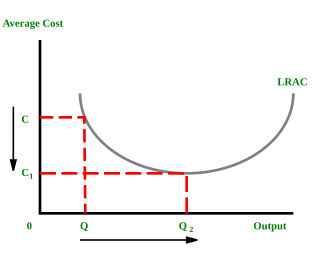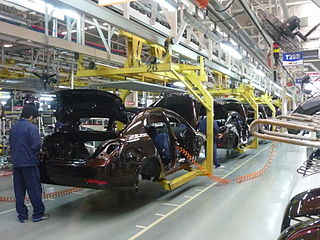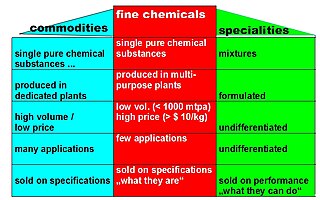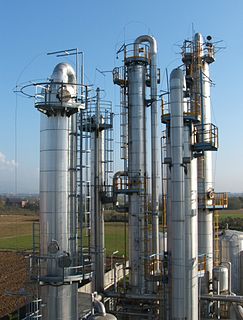
Biotechnology is the broad area of biology involving living systems and organisms to develop or make products, or "any technological application that uses biological systems, living organisms, or derivatives thereof, to make or modify products or processes for specific use". Depending on the tools and applications, it often overlaps with the (related) fields of molecular biology, bio-engineering, biomedical engineering, biomanufacturing, molecular engineering, etc.

In microeconomics, economies of scale are the cost advantages that enterprises obtain due to their scale of operation, with cost per unit of output decreasing with increasing scale.

Manufacturing is the production of products for use or sale using labour and machines, tools, chemical and biological processing, or formulation. The term may refer to a range of human activity, from handicraft to high tech, but is most commonly applied to industrial design, in which raw materials are transformed into finished goods on a large scale. Such finished goods may be sold to other manufacturers for the production of other, more complex products, such as aircraft, household appliances, furniture, sports equipment or automobiles, or sold to wholesalers, who in turn sell them to retailers, who then sell them to end users and consumers.
The Fischer–Tropsch process is a collection of chemical reactions that converts a mixture of carbon monoxide and hydrogen into liquid hydrocarbons. These reactions occur in the presence of metal catalysts, typically at temperatures of 150–300 °C (302–572 °F) and pressures of one to several tens of atmospheres. The process was first developed by Franz Fischer and Hans Tropsch at the Kaiser-Wilhelm-Institut für Kohlenforschung in Mülheim an der Ruhr, Germany, in 1925.

A chemical plant is an industrial process plant that manufactures chemicals, usually on a large scale. The general objective of a chemical plant is to create new material wealth via the chemical or biological transformation and or separation of materials. Chemical plants use specialized equipment, units, and technology in the manufacturing process. Other kinds of plants, such as polymer, pharmaceutical, food, and some beverage production facilities, power plants, oil refineries or other refineries, natural gas processing and biochemical plants, water and wastewater treatment, and pollution control equipment use many technologies that have similarities to chemical plant technology such as fluid systems and chemical reactor systems. Some would consider an oil refinery or a pharmaceutical or polymer manufacturer to be effectively a chemical plant.

Sonication is the act of applying sound energy to agitate particles in a sample, for various purposes such as the extraction of multiple compounds from plants, microalgae and seaweeds. The enhancement in the extraction of bioactive compounds achieved using sonication is attributed to cavitation in the solvent, a process that involves nucleation, growth, and collapse of bubbles in a liquid, driven by the passage of the ultrasonic waves. Ultrasonic frequencies (>20 kHz) are usually used, leading to the process also being known as ultrasonication or ultra-sonication.

The Forest Products Laboratory (FPL) is the national research laboratory of the United States Forest Service, which is part of USDA. Since its opening in 1910, the FPL has provided scientific research on wood, wood products and their commercial uses in partnership with academia, industry, tribal, state, local and other government agencies. The laboratory is headquartered in Madison, Wisconsin. The focus of the Forest Products Laboratory is to promote healthy forests and forest-based economies through the efficient, sustainable use of the Nation's wood resources.
In a scientific sense, a chemical process is a method or means of somehow changing one or more chemicals or chemical compounds. Such a chemical process can occur by itself or be caused by an outside force, and involves a chemical reaction of some sort. In an "engineering" sense, a chemical process is a method intended to be used in manufacturing or on an industrial scale to change the composition of chemical(s) or material(s), usually using technology similar or related to that used in chemical plants or the chemical industry.

Fine chemicals are complex, single, pure chemical substances, produced in limited quantities in multipurpose plants by multistep batch chemical or biotechnological processes. They are described by exacting specifications, used for further processing within the chemical industry and sold for more than $10/kg. The class of fine chemicals is subdivided either on the basis of the added value, or the type of business transaction, namely standard or exclusive products.

A fluidized bed reactor (FBR) is a type of reactor device that can be used to carry out a variety of multiphase chemical reactions. In this type of reactor, a fluid is passed through a solid granular material at high enough velocities to suspend the solid and cause it to behave as though it were a fluid. This process, known as fluidization, imparts many important advantages to the FBR. As a result, the fluidized bed reactor is now used in many industrial applications.
Cellulosic ethanol commercialization is the process of building an industry out of methods of turning cellulose-containing organic matter into cellulosic ethanol for use as a biofuel. Companies, such as Iogen, POET, DuPont, and Abengoa, are building refineries that can process biomass and turn it into bioethanol. Companies, such as Diversa, Novozymes, and Dyadic, are producing enzymes that could enable a cellulosic ethanol future. The shift from food crop feedstocks to waste residues and native grasses offers significant opportunities for a range of players, from farmers to biotechnology firms, and from project developers to investors.
Biogasoline is gasoline produced from biomass such as algae. Like traditionally produced gasoline, it contains between 6 (hexane) and 12 (dodecane) carbon atoms per molecule and can be used in internal-combustion engines. Biogasoline is chemically different from biobutanol and bioethanol, as these are alcohols, not hydrocarbons.
A pilot line is a pre-commercial production line that produces small volumes of new technology-based products, or employs new production technology, as a step towards the commercialisation of the new technology.

Project commissioning is the process of assuring that all systems and components of a building or industrial plant are designed, installed, tested, operated, and maintained according to the operational requirements of the owner or final client. A commissioning process may be applied not only to new projects but also to existing units and systems subject to expansion, renovation or revamping.
A minimum viable product (MVP) is a product with just enough features to satisfy early customers, and to provide feedback for future product development.
Bio Base Europe is an innovation and training center for the biobased economy. It is a platform that supports the development of sustainable, biobased products such as bio-chemicals, bio-plastics, bio-materials, bio-detergents, bio-energy, etc. from renewable biomass resources. Its mission is to stimulate sustainable development and economic growth by facilitating R&D and training for biobased process development. It consists of a Pilot Plant for the biobased economy located in the port of Ghent (Belgium), and a Training Center for the biobased economy in Terneuzen (Netherlands).
Speciality chemicals are particular chemical products which provide a wide variety of effects on which many other industry sectors rely. Some of the categories of speciality chemicals are adhesives, agrichemicals, cleaning materials, colors, cosmetic additives, construction chemicals, elastomers, flavors, food additives, fragrances, industrial gases, lubricants, paints, polymers, surfactants, and textile auxiliaries. Other industrial sectors such as automotive, aerospace, food, cosmetics, agriculture, manufacturing, and textiles are highly dependent on such products.
The scale of a chemical process refers to the rough ranges in mass or volume of a chemical reaction or process that define the appropriate category of chemical apparatus and equipment required to accomplish it, and the concepts, priorities, and economies that operate at each. While the specific terms used—and limits of mass or volume that apply to them—can vary between specific industries, the concepts are used broadly across industry and the fundamental scientific fields that support them. Use of the term "scale" is unrelated to the concept of weighing; rather it is related to cognate terms in mathematics, and in applied areas.













